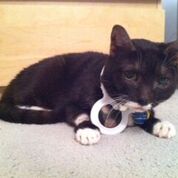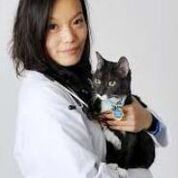Assisi Animal Health often receives calls from veterinarians who have heard of the Assisi Loop and want to learn more about how it works. Occasionally, they have a case that we haven’t used the Assisi Loop on. This was true recently with Dr. Andrea Y. Tu from Park East Animal Hospital. She called us about a case involving her own cat, Hazelnut, who has had several strokes and complications as a result. Following is her report on Hazelnut and the results of her case after 2 1/2 months of treatment with the Assisi Loop.
Description of Hazelnut and her Case
 Hazelnut is a 15-year-old FS DSH (female spayed domestic short-hair). She initially presented with two cerebral vascular accidents (“strokes”) in the cervical neck region. These occurred in August and September of 2013 and left her laterally recumbent (lying on her side and unable to stand). An MRI confirmed the strokes and she was started on physical rehabilitation only. She responded well and was able to regain ambulation with mild residual neurological deficits (mild limp).
Hazelnut is a 15-year-old FS DSH (female spayed domestic short-hair). She initially presented with two cerebral vascular accidents (“strokes”) in the cervical neck region. These occurred in August and September of 2013 and left her laterally recumbent (lying on her side and unable to stand). An MRI confirmed the strokes and she was started on physical rehabilitation only. She responded well and was able to regain ambulation with mild residual neurological deficits (mild limp).
In January 2014, she had a third stroke to the cervical neck region–again confirmed with an MRI. This time her left side was affected and she had marked torticolllis–her head leaning to the left–and neurological deficits on all limbs (worse on the left side) that again left her laterally recumbent. She also had cranial nerve deficits, resulting in a long-standing corneal ulcer in the left eye and decreased sensation to her tongue. The combination of the marked left head tilt, loss of sensation to the tongue, and the tendency to have the tongue fall and get stuck on the left side of the mouth resulted in the patient repeatedly causing self-trauma to the tongue. In addition to the corneal ulcer, the patient was also noted to have a Schirmer’s test* result of 0 in 60 seconds in the left eye (normal in the right eye). Finally, the strokes caused partial loss of speech–while the patient was still able to growl and hiss, she was unable to meow.
*Schirmer’s test determines whether the eye produces enough tears to keep it moist.
Treatment Rendered
 While weekly physical rehabilitation was initiated for the ambulation concerns, little could be done in the form of traditional rehabilitation exercises for the tongue. As such, Assisi Loop therapy was recommended and initiated at a once to twice a day regimen. The Loop was placed around the patient’s neck, thereby allowing stimulation in the oral cavity to encourage neovascularization (regeneration of blood vessels) and healing of the damaged tongue tissue. By placing the Loop around the neck, the cervical neck region where the three strokes occurred was also targeted with the hope that it would help decrease inflammation secondary to the stroke, increase neovascularization and promote overall recovery post-stroke. Syringe feeding was initiated as well to decrease the chances of repeated self-trauma during meals. Antibiotic and artificial tears therapy were also initiated for the corneal ulcer.
While weekly physical rehabilitation was initiated for the ambulation concerns, little could be done in the form of traditional rehabilitation exercises for the tongue. As such, Assisi Loop therapy was recommended and initiated at a once to twice a day regimen. The Loop was placed around the patient’s neck, thereby allowing stimulation in the oral cavity to encourage neovascularization (regeneration of blood vessels) and healing of the damaged tongue tissue. By placing the Loop around the neck, the cervical neck region where the three strokes occurred was also targeted with the hope that it would help decrease inflammation secondary to the stroke, increase neovascularization and promote overall recovery post-stroke. Syringe feeding was initiated as well to decrease the chances of repeated self-trauma during meals. Antibiotic and artificial tears therapy were also initiated for the corneal ulcer.
Results of Treatment
After 2 1/2 months of therapy, the patient is now ambulatory with residual deficits. She still falls to the left about 10-15% of the time. Her left-sided head tilt has improved markedly and the tongue injuries are fully healed. Her tongue no longer falls to the side or gets stuck. She is now able to eat on her own (including dry food which she prefers over canned food) without causing any trauma to her tongue.
The Assisi Loop therapy was decreased to once every other day after the initial 2 1/2 months of therapy. By this point (5 months after the last stroke), the patient’s tongue injuries have not reoccurred for the last 2 months. The corneal ulcer is also fully healed and the patient’s Schirmer’s tear test results improved to 7 in 60 seconds in the left eye. Her right eye remains normal (over 15 in 60 seconds). As a result, the patient still receives artificial tear therapy in the left eye. Finally, during the first week of June 2014, the patient was noted to meow for the first time since January 2014.
We are grateful to Dr. Tu for initiating an evaluation of the Assisi Loop for this case as we haven’t had any reports on this particular set of circumstances previously. It is always important to remember that the Assisi Loop is catalyzing the anti-inflammatory cascade and, as such, offers benefits for a variety of conditions. Learn more about tPEMF here.
